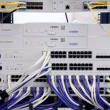It’s June, which means it’s time for the spring release of the Top500 list of supercomputers in the world… that we know of. It has long been suspected that there are other supercomputers out there that could easily make the top 10 of the list, or even surpass the No. 1 computer, El Capitan, but their owners and operators keep them a secret.
Nonetheless, this list that was once read only by HPC insiders is now a source of bragging rights for the vendors that make a strong showing. A lot has changed in the 31 years since it was created. Back in 1994, there wasn’t an X86 processor in sight. Now that’s all that’s on the list for CPUs.
We published details about the 10 most powerful supercomputers on the list, but here’s a deeper dive into the specifics of the list and who came out on top and in what way.
CPU winner: AMD
Nowhere is AMD’s resurgence shining more brightly than on the CPU side of things. In the June 2025 ranking, AMD’s Epyc processors are found in 162 systems, covering the 2nd through 4th generation of the Zen architecture. Last year, Epyc accounted for 155 of the systems, and in 2023, there were 121 Epyc-powered systems.
CPU loser: Intel
As AMD gains ground, Intel is ceding it. Intel Xeon processors can be found in 224 of the servers on this year’s list. In June 2024, it had 271 systems, while in June 2023, it had 315. That doesn’t account for the “other” category, which contains very old Intel and AMD generations along with also-rans like Sparc. Either way, Intel’s trajectory is in the wrong direction.
Win some, lose some: Nvidia
Of course Nvidia is going to dominate a list of top supercomputers, since its chips are used in so many systems. First up, the Grace CPU made its debut on the list with 13 systems. For this year’s list, Nvidia had 117 systems, representing a mix of different architectures and generations. That doesn’t include the “other” category, where older architectures tend to be lumped together. However, Nvidia also lost ground compared to last year when it had 134 systems on the list. That’s due to a GPU surge by AMD.
GPU winner: AMD
AMD is finally making a showing for itself, albeit modestly, in GPU accelerators. For the June 2025 edition of the list, AMD Instinct accelerators are in 23 systems, a nice little jump from the 10 systems on the June 2024 list. Of course, it helps with the sales pitch when AMD processors and coprocessors can be found powering the No. 1 and No. 2 supercomputers in the world.
GPU loser: Intel
Intel’s GPU efforts have been a disaster. It failed to make a dent in the consumer space with its Arc GPUs, and it isn’t making much headway in the data center, either. There were only four systems running GPU Max processors on the list, and that’s up from three a year ago. Still, it’s pitiful showing given the effort Intel made.
Server winners: HPE, Dell, EVIDAN, Nvidia
The four server vendors — servers, not component makers — all saw share increases. Nvidia is also a server vendor, selling its SuperPOD AI servers directly to customers. They all gained at the expense of Lenovo and Arm.
Server loser: Lenovo
It saw the sharpest drop in server share, going from 163 systems in June of 2024 to 136 in this most recent listing.
Loser: Arm
Other than the 13 Nvidia Grace chips, the ARM architecture was completely absent from this spring’s list.
